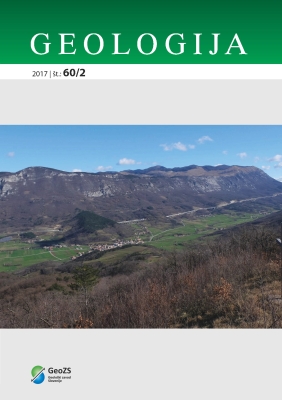Origin of planation surfaces in the hinterland of Šumljak sedimentary bodies in Rebrnice (UpperVipava Valley, SW Slovenia)
DOI:
https://doi.org/10.5474/geologija.2017.021Abstract
The Rebrnice area forms the north eastern slopes of the Upper Vipava Valley and is located between Karst plateau to the southwest and the Nanos plateau to the northeast. The Rebrnice slopes are geomorphologically defined by a thrust front of Mesozoic carbonates over Tertiary flysch deposits and are characterised by a variety of polygenetic landslides (being the most prominent geomorphological features). Among them, the three Šumljak sedimentary bodies of fossil landslides (approximately 0.56 km2 in area) comprise carbonate gravels and breccia. The most distinctive geomorphological element is the planation surface of the carbonate breccia blocks positioned in the hinterland of the Šumljak sedimentary bodies. Another feature is the presence of local escarpments (steep scarps) defining the border between the planation surface in the hinterland and sedimentary bodies. Our research suggests that the whole area in the hinterland of the Šumljak sedimentary bodies form part of a deep-seated rotational landslide formed of carbonate breccia. On the basis of the dipping of the breccia beds, in particular parts of the rotational blocks, the rotation can reach up to 60°. Planation surfaces developed above the curved, sliding plane in the central part and/or slightly outer part of the landslide. Steep scarps on the external parts of the planation surface represent the main scarps of the Šumljak sedimentary bodies. We propose that these bodies originated from the remobilization of material accumulated in outer parts of large-scale rotational slides and its transportation further downslope, mostly by rock avalanches.Downloads
How to Cite
Popit, T. (2017). Origin of planation surfaces in the hinterland of Šumljak sedimentary bodies in Rebrnice (UpperVipava Valley, SW Slovenia). Geologija, 60(2), 297–307. https://doi.org/10.5474/geologija.2017.021
Issue
Section
Articles

